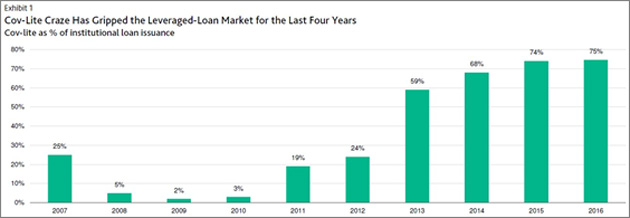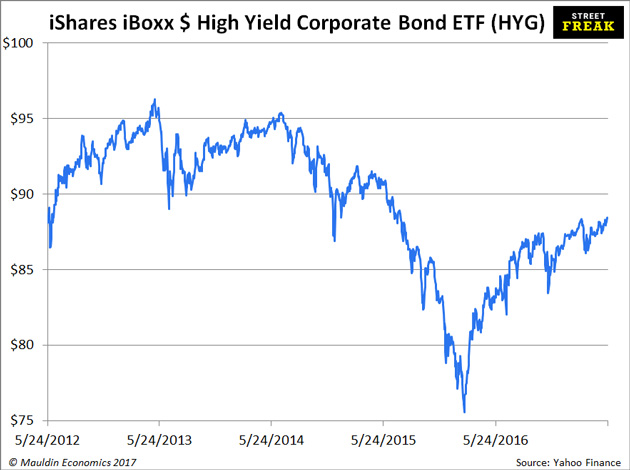| -- | May 25, 2017 My Name Is Fester. It Means “To Rot.”  There has been a bit of a buzz the last couple of days about covenant-lite bonds. This isn’t really new news—you can see from the chart below that cov-lite issuance has been high for a few years now. But the old-timers know that when the cov-lite paper comes out, it is usually towards the end of a cycle. 
Source: @tracyalloway Let me define a few terms here, first. When a company issues bonds, those bonds usually come with a legal agreement called an indenture. The indenture has covenants which provide constraints on the borrower’s behavior over the duration of the loan. There are no such restrictions on consumer debt. If you take out a car loan, and then you take out a bunch of student loans on top of it, there is not much the bank can do about it. But in the world of corporate debt, you can. Bond covenants can take the form of restrictions on taking out additional debt, or maintenance of certain financial ratios, like interest coverage; stuff like that. If a borrower is found to be in violation of the covenants, the debt can be downgraded by a rating agency, or can be pushed into technical default. Covenant-lite is when a company borrows from the public basically free of any restrictions whatsoever—kind of like your car loan. If they want to borrow from you, and then go and take out a bunch of additional debt, they can. Here is how credit markets work. During bear markets, nobody trusts anybody, and bond indentures are full of covenants. In 2009, during the financial crisis, only 2% of bonds that year were considered to be covenant-lite. Now, about 75% of bond deals are cov-lite, and it’s been that way for a while. At the top of the cycle, all the cov-lite deals come out. And bond investors are usually very sorry a few years later—when default rates rise, and recovery rates are far below where they would otherwise be.  PIK-toggle The other thing that usually happens at the top of credit cycles is that the PIK-toggle bonds come out. PIK stands for payment-in-kind. The borrower has the option of making its interest payments in cash…or more bonds! This is very much like the negative amortization mortgages or option adjustable-rate mortgages (ARMs) that were going around during the housing bubble last decade. I don’t currently have data on PIK issuance, but it’s definitely high. All of this is when yields (and coupons) on debt are at historical lows, and people are taking on this immense additional risk just to get a 5% yield on very risky paper. Here’s a chart of HYG, which is considered to be the benchmark high-yield ETF. It’s not a complete picture of the high-yield market, but it’s close enough.  The Default Rate You can own a cov-lite PIK-toggle piece of paper yielding 5-6% if it doesn’t default. What would make it likely to default? Well, generally, default rates are low during expansions and high during recessions. In fact, when credit starts to croak, it is usually a pretty good leading indicator of a recession. During a recession, default rates can skyrocket to 10 or 12 or even 15 percent—annually. The cumulative probability that a given 5-year bond will default is very high. Yields get out to very high—and attractive levels. I’ve had some success in timing credit cycles over my career. One of my greatest trades (even though it was small, because I was still young and poor) was to buy a high-yield convertible bond fund pretty much at the lows of the credit cycle in 2002. The yields were astounding. I like buying 14% bonds, not 5% bonds. Don’t you? The Trade What is the trade? The trade is to evaluate your holdings of corporate debt, even the investment grade stuff. A lot of investors have been pushed out the risk curve into high yield by low interest rates, and that’s not good. People have short memories about how exciting credit can get during a downturn. It’s even worse when you think about some of the possibility liquidity issues that the bond market could have in a disorderly market. Lots of people think you have to short stuff to be a smart investor. Shorting is hard. I don’t like shorting stuff… Most of the time, just not buying it is good enough. Cash is great. Keep your powder dry until the next downturn, get some of those 12-14% bonds. It feels like I bring this up every other week—cash cash cash cash cash. Cash is an option to buy something at a lower price later. As the price of nearly everything is high right now, it’s a great time to hang out in cash. One of the hardest things to do in investing is to wait—especially, to wait for an opportunity to come along. You feel like your money isn’t working for you. Yes, it’s a shame that there’s little-to-no interest in a bank account. That doesn’t mean you have to go out and take stupid risks just to make a couple hundred basis points. Stepping off the soapbox now. 
Jared Dillian
Editor, The 10th Man
 | Get Thought-Provoking Contrarian Insights from Jared Dillian
Meet Jared Dillian, former Wall Street trader, fearless contrarian, and maybe the most original investment analyst and writer today. His weekly newsletter, The 10th Man, will not just make you a better investor—it's also truly addictive. Get it free in your inbox every Thursday. |
Jared's premium investment service, Street Freak, is available now. Click here for our introductory offer. Jared Dillian, former head of ETF Trading at one of the biggest Wall Street firms and author of the highly acclaimed books, Street Freak: Money and Madness at Lehman Brothers , and All the Evil of This World , shows you how to pick and trad e trends, and master your inner instincts. Learn how to use “Angry Analytics” as a leading indicator of budding trends you can profit from… and how to view any market situation through the lens of a trader. Jared’s keen insight into market psychology combined with an edgy, provocative voice make Street Freak an investment advisory like no other. Follow Jared on Twitter at @dailydirtnap. Share Your Thoughts on This Article
 http://www.mauldineconomics.com/members
Use of this content, the Mauldin Economics website, and related sites and applications is provided under the Mauldin Economics Terms & Conditions of Use. Unauthorized Disclosure Prohibited The information provided in this publication is private, privileged, and confidential information, licensed for your sole individual use as a subscriber. Mauldin Economics reserves all rights to the content of this publication and related materials. Forwarding, copying, disseminating, or distributing this report in whole or in part, including substantial quotation of any portion the publication or any release of specific investment recommendations, is strictly prohibited.
Participation in such activity is grounds for immediate termination of all subscriptions of registered subscribers deemed to be involved at Mauldin Economics’ sole discretion, may violate the copyright laws of the United States, and may subject the violator to legal prosecution. Mauldin Economics reserves the right to monitor the use of this publication without disclosure by any electronic means it deems necessary and may change those means without notice at any time. If you have received this publication and are not the intended subscriber, please contact service@mauldineconomics.com. Disclaimers The Mauldin Economics website, Yield Shark, Thoughts from the Frontline, Patrick Cox’s Tech Digest, Outside the Box, Over My Shoulder, World Money Analyst, Street Freak, Just One Trade, Transformational Technology Alert, Rational Bear, The 10th Man, Connecting the Dots, This Week in Geopolitics, Stray Reflections, and Conversations are published by Mauldin Economics, LLC. Information contained in such publications is obtained from sources believed to be reliable, but its accuracy cannot be guaranteed. The information contained in such publications is not intended to constitute individual investment advice and is not designed to meet your personal financial situation. The opinions expressed in such publications are those of the publisher and are subject to change without notice. The information in such publications may become outdated and there is no obligation to update any such information. You are advised to discuss with your financi al advisers your investment options and whether any investment is suitable for your specific needs prior to making any investments.
John Mauldin, Mauldin Economics, LLC and other entities in which he has an interest, employees, officers, family, and associates may from time to time have positions in the securities or commodities covered in these publications or web site. Corporate policies are in effect that attempt to avoid potential conflicts of interest and resolve conflicts of interest that do arise in a timely fashion.
Mauldin Economics, LLC reserves the right to cancel any subscription at any time, and if it does so it will promptly refund to the subscriber the amount of the subscription payment previously received relating to the remaining subscription period. Cancellation of a subscription may result from any unauthorized use or reproduction or rebroadcast of any Mauldin Economics publication or website, any infringement or misappropriation of Mauldin Economics, LLC’s proprietary rights, or any other reason determined in the sole discretion of Mauldin Economics, LLC. Affiliate Notice Mauldin Economics has affiliate agreements in place that may include fee sharing. If you have a website or newsletter and would like to be considered for inclusion in the Mauldin Economics affiliate program, please go to http://affiliates.pubrm.net/signup/me. Likewise, from time to time Mauldin Economics may engage in affiliate programs offered by other companies, though corporate policy firmly dictates that such agreements will have no influence on any product or service recommendations, nor alter the pricing that would otherwise be available in absence of such an agreement. As always, it is important that you do your own due diligence before transacting any business with any firm, for any product or service. © Copyright 2017 Mauldin Economics | -- |
